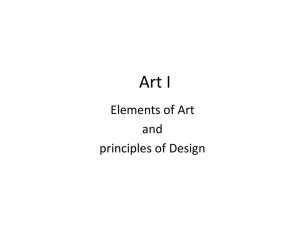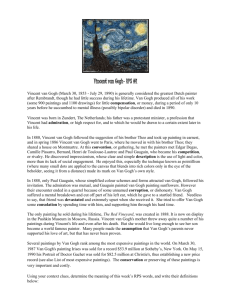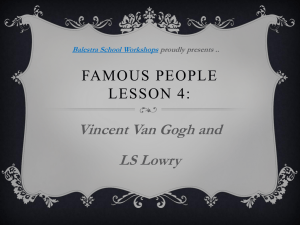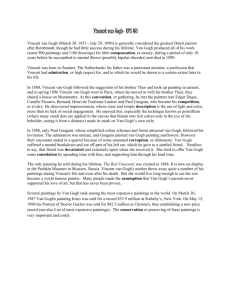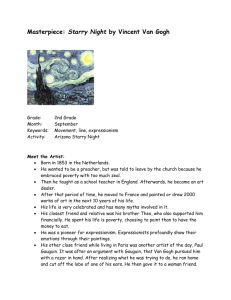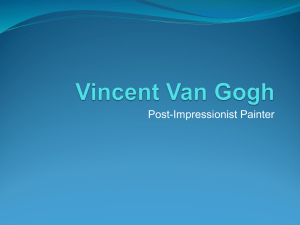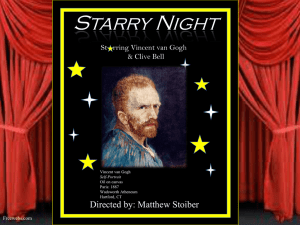Biographie - Kunstmuseum Basel
advertisement
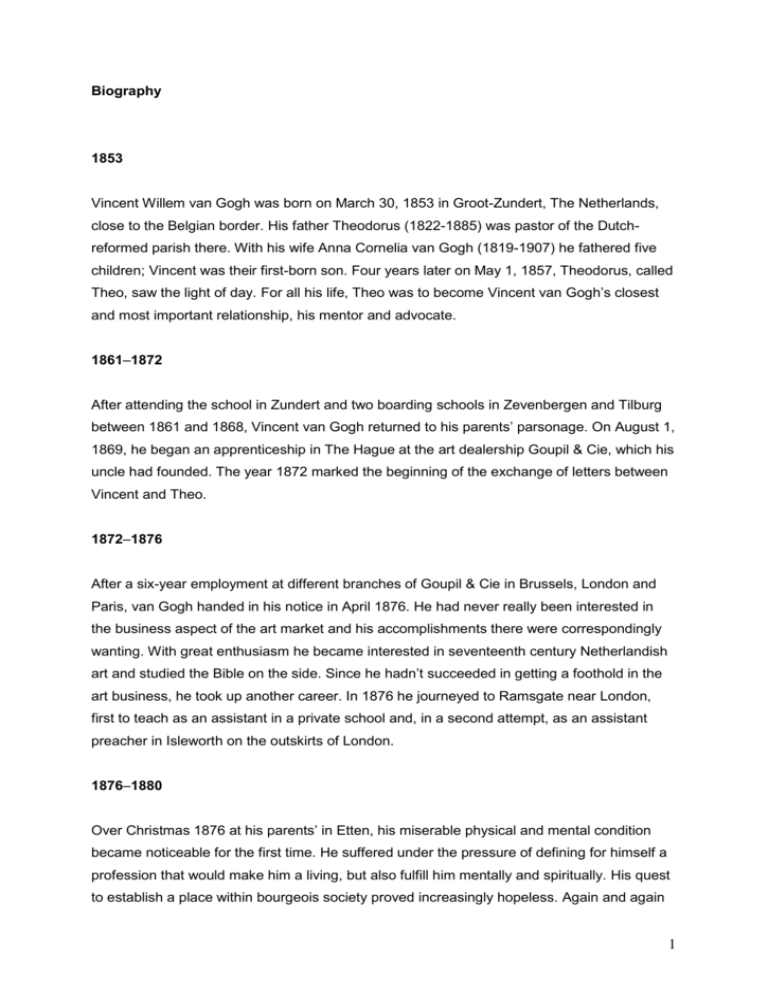
Biography 1853 Vincent Willem van Gogh was born on March 30, 1853 in Groot-Zundert, The Netherlands, close to the Belgian border. His father Theodorus (1822-1885) was pastor of the Dutchreformed parish there. With his wife Anna Cornelia van Gogh (1819-1907) he fathered five children; Vincent was their first-born son. Four years later on May 1, 1857, Theodorus, called Theo, saw the light of day. For all his life, Theo was to become Vincent van Gogh’s closest and most important relationship, his mentor and advocate. 1861–1872 After attending the school in Zundert and two boarding schools in Zevenbergen and Tilburg between 1861 and 1868, Vincent van Gogh returned to his parents’ parsonage. On August 1, 1869, he began an apprenticeship in The Hague at the art dealership Goupil & Cie, which his uncle had founded. The year 1872 marked the beginning of the exchange of letters between Vincent and Theo. 1872–1876 After a six-year employment at different branches of Goupil & Cie in Brussels, London and Paris, van Gogh handed in his notice in April 1876. He had never really been interested in the business aspect of the art market and his accomplishments there were correspondingly wanting. With great enthusiasm he became interested in seventeenth century Netherlandish art and studied the Bible on the side. Since he hadn’t succeeded in getting a foothold in the art business, he took up another career. In 1876 he journeyed to Ramsgate near London, first to teach as an assistant in a private school and, in a second attempt, as an assistant preacher in Isleworth on the outskirts of London. 1876–1880 Over Christmas 1876 at his parents’ in Etten, his miserable physical and mental condition became noticeable for the first time. He suffered under the pressure of defining for himself a profession that would make him a living, but also fulfill him mentally and spiritually. His quest to establish a place within bourgeois society proved increasingly hopeless. Again and again 1 he attempted to fit in, yet could not. Likewise his attempt to take up the study of theology was doomed to failure. The academic conventions of the curriculum proved too much for him. Before he was to finally decide on an artistic career, he offered support to a mining community in Belgium one year long as a lay preacher. And yet, at this place neither was he granted any confirmation or recognition of his work. His passionate engagement clashed with the ideas of his superiors. Van Gogh was dismissed. 1880–1881 After van Gogh had overcome several other crises and revived the long interrupted correspondence with Theo, he took up an artistic career for good. Theo, who in the meantime was working in Paris at Goupil & Cie, supported Vincent’s plan and from now on backed him financially. In October Vincent signed up at the Art Academy in Brussels, in order to acquire a grounding in academic drawing techniques. He was, however, more at ease as an autodidact and left the Brussels academy. Before he went to The Hague at the end of 1881, he spent a year with his father and mother in Etten. His stay there ended in a dispute, since it had become clear that Vincent’s ideas of a self-determined life as a painter would take place outside of the boundaries of bourgeois society. From this moment on, he took up the position of an outsider. At the same time, Vincent had again to struggle with depression. Thoughts of suicide appeared for the first time. 1881–1883 Once in The Hague, he began the life of a free artist. He made the acquaintance of artists from the Hague School and availed himself of the stimulation he received from his cousin Anton Mauve (1838-1888), who was an important Netherlandish landscape painter from The Hague School. Under the guidance of Mauve, his first still lifes came about. During this Hague phase, he often worked before nature and discovered oil painting for himself. 1883–1885 After a three-month stay in Holland’s northern province of Drente, van Gogh returned to his parents’ in 1883, who had in the meantime taken up residence in Nuenen in Nord-Brabant. His relationship with his parents remained tense and difficult. Friendship with the painter Anthon van Rappard (1885-1892) had a positive impact on his artistic development. In 1885, he worked on his first and, simultaneously his last, multi-figure composition, The Potato 2 Eaters. In the same year his father suffered a stroke and died. Despite all the conflicts between them, Vincent was deeply upset by the death of his father. At the end of October, he set off for Antwerp to try his luck at the painting and drawing class of the École des BeauxArts. 1886–1888 In the spring of 1886, van Gogh left for Paris, the focal point of European art activity. In these years Paris was the world metropolis per se, where all the new trends and intellectual movements ran their course; the city was virtually a symbol of the dawn of Modernism. Van Gogh arrived there not unprepared: he was familiar with contemporary literature and art theory and, via his brother, had learned of the newest developments in art. Vincent began by attending the studio of Fernand Cormon (1845-1825) for four months. Here Vincent met John Russell (1858-1931), Henri de Toulouse-Lautrec (1864-1901) and Emile Bernard (18681941). Thanks to Theo, who worked at the Galerie Valadon & Boussod on Boulevard Montmartre, he met Impressionist artists personally, among whom were Claude Monet (1830-1926), Pierre-Auguste Renoir (1841-1919), Alfred Sisley (1839-1899), Camille Pissarro (1830-1903), Edgar Degas (1834-1917), Paul Signac (1863-1935) and Georges Seurat (1859-1891). Under their influence, van Gogh abandoned his brown colors and earth tones and adopted a lighter palette. In June, Vincent took an apartment with his brother Theo in the rue Lepic on Montmartre. Vincent set up his own studio within the apartment. That winter Vincent made friends with Paul Gauguin (1848-1903), who had arrived in Paris from Brittany. In 1887, van Gogh participated in an exhibition at the Café du Tambourin with works by Bernard, Gauguin and Toulouse-Lautrec, where he showed his Japanese color woodcuts. Other pictures Vincent exhibited with Bernard and Toulouse-Lautrec, among others, at the Restaurant du Chalet. Together the artists traded under the name “Peintres du Petit Boulevard”. 1888–1889 For Theo, living together with his brother became increasingly problematic; he agreed with his brother when, in February 1888, Vincent wanted to turn his back on the turbulent life in Paris and depart for Arles in the south of France. The fresh, bright colors and the warm atmosphere of the south drew van Gogh to Provence. There he produced almost two hundred paintings and over one hundred drawings and watercolors. In the spring of 1888 his 3 paintings depicted orchards; in the summer, scenes of the wheat harvest. Along with landscapes, van Gogh worked on a series of portraits in August 1888. In addition, he dreamed of founding an artists’ community in Arles. From the beginning of his artistic activity, he had always been inspired by the idea of working and living together with colleagues. Vincent wrote to his Paris artist friends and invited them to Arles; but Gauguin was the only one who reacted to his invitation concretely, after Theo agreed to finance his stay there. In the autumn, van Gogh lived in the right wing of the Yellow House on Place Lamartine. That fall, Gauguin announced his arrival in Arles. In anticipation of his admired friend, van Gogh designed an entire pictorial program called “Décoration”, with which he wanted to embellish the living and work rooms. He conceived of twin pictures that would make companion pieces in their coloring and corresponding subject. Gauguin finally arrived on October 23rd. Van Gogh was so happy that his dream of an artist’s community seemed to be fulfilled. He believed he had found a kindred spirit in Gauguin. Unfortunately this close association was not to last long. The relationship between the effusive Gauguin and the depressive, overwrought van Gogh suffered from constant friction. It soon erupted in a confrontation. In a fit, van Gogh mutilated his left ear during the night of December 23rd 1888. On the following morning, Vincent was found by the police and transported to a hospital. Meanwhile Gauguin left Arles and informed Vincent’s brother, Theo. On January 7, 1889 Vincent returned to live in his apartment in the Yellow House. To the citizens of Arles, van Gogh’s illness was uncanny; they arranged for him to be interned in a hospital. They named him “fou roux”, red-haired madman. Fearful himself of the unpredictability of his illness and his mental health, van Gogh presented himself voluntarily at the sanatorium Saint-Paul-de-Mausole near Saint-Rémy. He moved into a room there on 8 May 1889. Still today the exact diagnosis of his illness is in dispute. Some indications point to the fact that he suffered from a temporal lobe epilepsy or a genetic disorder. His strong alcohol consumption and an inadequate diet additionally worsened his mental as well as physical condition. In the sanatorium, Vincent had two rooms at his disposal, which Theo paid for. One of the rooms served him as a studio. While during his phases of poor health he did no work and also wrote no letters, he always became productive as soon as he felt better. Thus more than once he painted the view from his window onto a walled-in field that belonged to the sanatorium garden. Painting was for him both therapy and a calling. In this way and despite the circumstances, he turned out many paintings and drawings at Saint-Rémy. In October Vincent was allowed to work outdoors in accompaniment. Motifs that are frequent are now the hills of the Alpilles, as well as olive trees and cypresses, which to him were symbols of the southern French landscape. 4 1889–1890 Between the autumn of 1889 and the spring of 1890, works by van Gogh were exhibited at the Salon des Indépendants in Paris, at Les Vingt in Brussels and, lastly, at the 1890 Salon des Indépendants. Art critics, such as Albert Aurier (1865-1892) or Joseph Jacob Isaacson (1859-1939) published appreciative articles on van Gogh. At the advice of Camille Pissarro, Theo agreed that his brother be transferred in May 1890 to Auvers-sur-Oise, about thirty kilometers from Paris. There Paul Gachet lived—doctor, collector and amateur artist—who offered to look after van Gogh personally. In March and April, van Gogh had suffered from very bad breakdowns and had stopped painting. Now he was doing better and was welcomed into the Gachet family circle on a regular basis. Over the next two months, Vincent worked at his art with great enthusiasm. Over eighty paintings were the result, above all, landscapes and portraits. Van Gogh painted a portrait, among others, of the daughter Marguerite Gachet at the piano. Van Gogh became friends with the Dutch painter Anton Matthias Hirschig (1867-1939), who moved into the room next to him. Vincent suffered under the situation of his financial dependency on Theo. Above all after Theo’s marriage and the birth of his son, he felt guilty that the young family was burdened by having to support him. Van Gogh wrote his last letter to Theo on July 23. Two days later, Vincent turned a pistol on himself during an evening walk. The wound was cleaned, but the bullet could not be removed. Theo, who arrived in Auvers from Paris immediately on receiving the bad news, sat by his bedside. On July 29, 1890, Vincent van Gogh died at the age of thirty-seven as a result of his attempted suicide. Theo had difficulty coping with the unexpected death of his older brother. His health, too, was not good; he traveled to Holland for treatment. On January 25, 1891, Theo van Gogh died in Utrecht. The two brothers are buried at the cemetery in Auvers. 5
